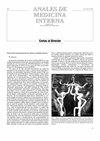Diagnostic management of solitary pulmonary nodule
引用次数: 7
Abstract
Solitary pulmonary nodule (SPN) is defined as a single, approximately round and well-circumscribed radiographic opacity ƒ3 cm in diameter which is completely surrounded by normal aerated lung parenchyma, without other abnormalities such as lymph node enlargement, atelectasis or pleural effusion [1]. The diagnosis of an SPN is a very common clinical problem and several pathological processes, both benign and malignant, may determine a solitary nodular lesion in the lung (table 1) [2]. Optimal management of SPN should allow the resection of all malignant nodules without delay and avoid useless surgery of benign nodules. How to reach this goal is an age old problem [3] and still remains today. Despite huge technological advancements in this diagnostic field, no widely accepted evidence-based guidelines completely address the approach to SPN [4]. In the last few years some new developments have changed the concept of managing SPN [5]. The widespread use of computed tomography (CT), the introduction of spiral and multi-detector row CT and the performance of CT-based screening programmes have greatly increased the identification of small subcentimetric nodules. The results from lung cancer screening projects show that noncalcified nodules are found in 20–50% of asymptomatic smokers or ex-smokers [6, 7]. The clinical meaning of these small lesions is different from the nodules detected by chest radiographs, generally .1 cm, for which the probability of malignancy is very high (64–82% for SPN .2 cm) [8] and for which the assumption that they should be considered malignant until proved otherwise is widely accepted. On the contrary, ,1% of nodules ,5 mm are malignant in patients without any previous history of cancer [9]. The likelihood of malignancy increases with the nodule size, being 0.2% for nodules ,3 mm, 0.9% for those 4–7 mm, 18% for those 8–20 mm [10] and y80% for nodules .20 mm [11]. The differences in epidemiology, clinical meaning and prognosis of subcentimetric nodules in comparison to nodules .1 cm prompt us to propose a separate specific management for these kinds of lesions. Scientific societies should probably also review the terminology for SPNs, taking into account that there should be a distinction between small and larger nodules when defining them (fig. 1). Furthermore, thanks to the diffusion of the CT scan, other new concepts concerning the morphology of SPNs have been introduced. The identification of nodules with a pure ground-glass attenuation pattern (ground-glass opacity) (fig. 1) or with a mixed solid component and ground-glass opacity, may have a different meaning in comparison with solid SPNs. In fact, nodules with ground-glass opacity pattern, even if they could represent conditions such as focal fibrosis, haemorrhage, inflammation and atypical adenomatous hyperplasia [12], are more likely to be malignant (70–100%) than solid孤立性肺结节的诊断处理
孤立性肺结节(SPN)定义为单个,直径约为圆形,界限清楚的x线不透明ƒ3 cm,完全被正常充气肺实质包围,无其他异常,如淋巴结肿大,肺不张或胸腔积液[1]。SPN的诊断是一个非常常见的临床问题,几个病理过程,无论是良性的还是恶性的,都可以确定肺部的孤立结节性病变(表1)。SPN的最佳治疗方法是及时切除所有恶性结节,避免对良性结节进行无用的手术。如何实现这一目标是一个古老的问题,今天仍然存在。尽管在这一诊断领域取得了巨大的技术进步,但没有广泛接受的循证指南完全解决SPN bbb的方法。在过去几年中,一些新的发展改变了管理SPN b[5]的概念。计算机断层扫描(CT)的广泛使用,螺旋和多探测器行CT的引入以及基于CT的筛查程序的性能大大增加了对亚厘米小结节的识别。肺癌筛查项目结果显示,在20-50%的无症状吸烟者或戒烟者中发现非钙化结节[6,7]。这些小病变的临床意义与胸片上发现的结节不同,一般为0.1 cm,其恶性概率非常高(SPN为0.2 cm, 64-82%)[8],在证实其他情况之前,它们应被认为是恶性的假设被广泛接受。相反,在没有任何癌症病史的患者中,1% (5mm)的结节是恶性的。恶性肿瘤的可能性随着结节大小的增加而增加,3毫米的结节为0.2%,4-7毫米的为0.9%,8-20毫米的为18%,20毫米的为80%。与0.1 cm结节相比,亚厘米结节在流行病学、临床意义和预后方面的差异促使我们对这类病变提出单独的具体治疗方法。科学团体可能也应该审查spn的术语,考虑到在定义它们时应该区分小结节和大结节(图1)。此外,由于CT扫描的普及,已经引入了关于spn形态的其他新概念。与固体spn相比,纯磨玻璃衰减模式(磨玻璃不透明)(图1)或混合固体成分和磨玻璃不透明的结节的识别可能具有不同的意义。事实上,毛玻璃样混浊的结节,即使可能代表局灶性纤维化、出血、炎症和非典型腺瘤性增生[12],也更有可能是恶性的(70-100%),而不是实性的
本文章由计算机程序翻译,如有差异,请以英文原文为准。
求助全文
约1分钟内获得全文
求助全文

 求助内容:
求助内容: 应助结果提醒方式:
应助结果提醒方式:


